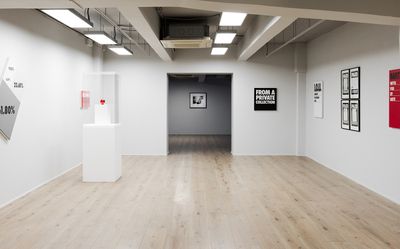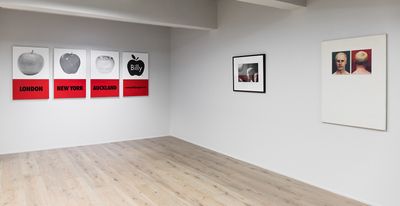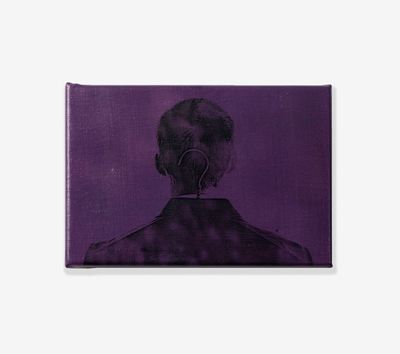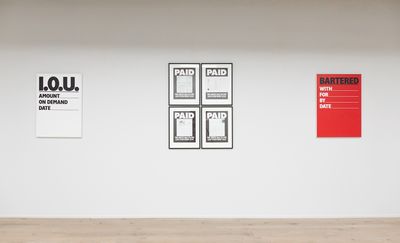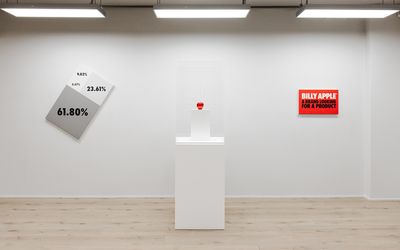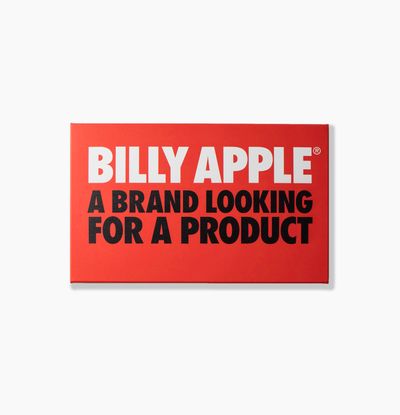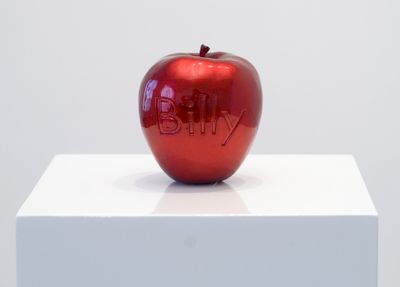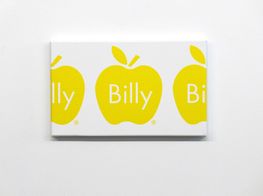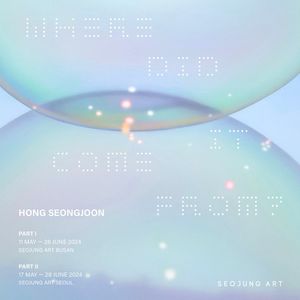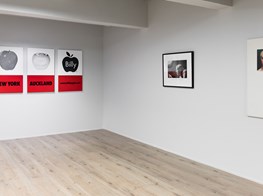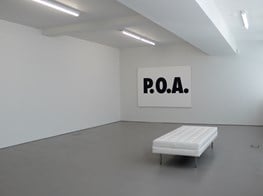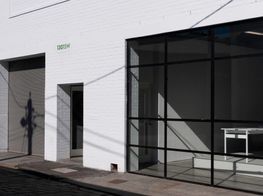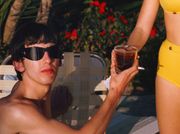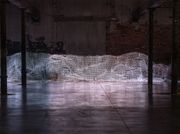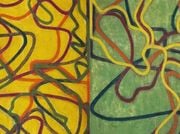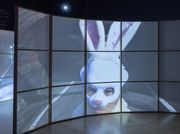Billy Apple: In Focus

Billy Apple at the opening of Billy Apple® Six Decades 1962–2018, Rossi & Rossi, Hong Kong (9 June–28 July 2018). Courtesy Rossi & Rossi.
To present 21 works in Hong Kong, spanning approximately six decades (1962–2018), is an unusual occasion for Billy Apple, a groundbreaking New Zealand-born artist whose pop-infused conceptual practice is mostly acknowledged in New Zealand, England (where he studied and worked from 1959 to 1964) and the United States (where he lived from 1964 to 1990).
Titled Billy Apple® Six Decades 1962–2018 (9 June–28 July 2018), the exhibition at Rossi & Rossi showcases some of Apple's dominant artistic preoccupations, selected by Wellington's Adam Art Gallery Te Pātaka Toi director Christina Barton. Five categories emerge that circle around the notion of personal identity: the artist's body; the body's physical activities; the body's mental stress; the body/brand and its developing symbols; and the brand as income earner. These groupings approximately parallel the layout of the exhibition.
Billy Apple was born as Barrie Bates in Auckland in 1935. In 1962, after studying graphic design at the Royal College of Art in London (where he was considered precocious and, to help his research, given access to all departments), he invented a new identity for himself as 'Billy Apple', constructing a new physical and psychological presence. As a student he was interested in the commercial aspects of art and the mechanics of its selling (in 1961 the then Bates presented a canvas bearing only the words 'For Sale'), and he became interested in the notion of presenting himself as a product with brand. As a schoolboy he was nicknamed 'Billy Pirate' and in his research he created a list of other possible names like 'Peter Pear', analysing their merits with a London friend, the painter Richard Smith. After the switch, Apple refused to answer to his earlier birth name, initially cutting off ties with his family in New Zealand.
Extremely interested in product design (and different technical production processes) and promotion—with his brand name and appearance now finessed—Apple then began applying these concepts to himself as a working avant-garde artist so that his body, its by-products and activities were—by definition—also artworks, and as such, commercial objects that could be marketed in the long run no matter how process-oriented, developing a visually slick, advertising, marketing sensibility. Eight works in his Hong Kong show exemplify this focus. Four of these—the photograph, Billy Apple Bleaching with Clairol Instant Crème Whip, November 1962 (1962/1997); the photo-lithograph on linen, Self-Portrait (Apple sees Red on Green) (1962–1963), with apple-coloured red and green backdrops; and two xerographs on spray-painted linen: Portrait of the Artist in a Drip-Dry Suit (Red) (1962); Portrait of the Artist in a Drip-Dry Suit (Purple) (1964)—look at the Clairol bleaching of the artist's hair in 1962. (Becoming blonde was a way of socially declaring his new 'art' identity to his circle of friends in London and the art world in general.) Portrait of the Artist in a Drip-Dry Suit (Red) shows the artist wearing a suit with his back to the camera lens, a wire hanger protruding from his jacket's neck.
Other works expand on the concepts around which advertising is based, including the notion of immortality, or 'eternal youth'. Created some 50 years after his artistic transformation, The Artist Will Live Forever (2016) is a printed text painting. It references Apple's gifting (as part of a collaboration with geneticist Dr Craig Hilton) various samples of somatic cell tissue to a Massachusetts research organisation, American Type Culture Collection, and the laboratory of Auckland Professor Rod Dunbar, where in both cases they are now being kept alive in special incubators, and are studied for cancer research, and the possibilities of immortality through cloning. The Immortalisation of Billy Apple® (2009–2015), is a black-and-white photo of an elderly Apple looking at his live cells through a microscope, with nearby in the same room, the looped video, The Immortalisation of Billy Apple® Stage Two, Billy Apple® Cell Line (2010), showing those microscopic cells multiplying. Among this grouping is I Consent (2009/2015): a canvas-based text documenting a consent form that Apple signed in 2009 as part of the contract around his donation of cellular material for research. It ensures he understands that this 'may enable unrestricted use of [his] cells in research outside [his] control.'
Overall, these two types of body-referencing artwork are like bookends: four at the start of Apple's career, and four referencing a project which, as Apple's body nears its physical end, could surprisingly carry on long after its disappearance, potentially reappearing in other iterations.
The second thematic grouping is that of the body's physical activities being used to make more artworks in a non-biological sense by way of subtractive principles, like that of stone carving whereby material is removed as a means of making a form, and perhaps by virtue of contagious magic, where one artwork creates others through mere touch (a psychological concept famously discussed by the anthropologist and folklorist, Sir James Frazer).
Three works all in the same room are: Four Activities: Sweeping, Vacuuming, Mopping, Washing, 20 March 1971 (1971), made in New York and documented by black-and-white photographs; Spot Cleaning (Hong Kong) (1971/2018), a text-based representation of the actual tools used for cleaning the wall they are displayed in front of; and Self-elimination Portrait, 27 March 1974 (1974), for which the artist used a chemical called Erasol to remove three layers of ink from a pair of self-portraits on an offset photo-lithographic zinc plate, with the remnants successively printed on three paper sheets. The lithographic works could be a wry comment on the elimination of Barrie Bates, or a possibly conflicted Billy Apple eradicating himself.
Among these groups, a sculpture of four neon 'knots' resting on a highly reflective perspex vitrine in a darkened room—Four Blue Knots for R. D. Laing (1966/2017)—seems at odds with the rest of the show, because it deals with the self's interiority rather than its surface appearance. The lightwork references Knots, the 1970 book of poems by the controversial Scottish psychiatrist R. D. Laing, known as the 'high priest of anti-psychiatry'1 who explored the divided nature of self, relation and family. It seems to imply a tortuous relationship between Billy Apple and his family, and the tension between his personal history before 1962 (parts that perhaps he later denied to himself), and his advancing art career after that.
This tension manifested itself, too, in the legal implications of maintaining Apple's brand as an artist. How can a constructed 'art' brand protect itself from usurpers (artists or advertisers) by maintaining 'originality', while attracting financial support? The xerograph, Apple Core (2 minutes, 33 seconds) (1966) shows the remains of an apple after its flesh has been consumed, here turned into a symbol for Apple's life ('consumed' by time) as well as his branding motif.
With the help of law firm Minter Ellison Rudd Watts, Apple's constructed name and logo legally acquired the status of a registered trademark in 2007. Employing a legal team obviously involved raising funds; for Apple, it was to cost at least NZD 80,000. In order to do that, he organised a large red wall mural in 2005, whose documentation is not included in his Hong Kong show, stating that Minter Ellison Rudd Watts had provided him with NZD 100,000 credit—as payment for the mural itself. This was painted in their Auckland offices, and five years later was supplemented by another work, a smaller painting on a stretcher, declaring a NZD 23,610 top up had occurred. Later on, smaller still, NZD 9,020 and NZD 5,570.
The logic behind such transactional works can be witnessed at Rossi & Rossi in wall works such as Paid: The Artist Has to Live Like Everybody Else (1987), which shows four collectively framed invoices—including rates and property rental bills that buyers have settled in order to acquire these works—attached to cards with explanatory printed texts. Bartered (Untransacted) (1984/2018) is a canvas of a red, untransacted potential swap, with the 'with', 'for', 'by' and 'date' spaces left blank—they need to have their details filled in before the artist signs the canvas agreeing to hand it over. Similarly, the printed canvas, IOU (Untransacted) (1987/2018) shows an amount-on-demand line and a date line that needs to be filled in before Apple confirms he will refund the money on request.
One reoccurring tool that Apple has made good use of throughout his career is the Golden Rectangle, the set of 'Divine' proportions, a mathematical system that he admires to the point of obsession. Art and Life Business Plan (1985/2018), is a single canvas version of an earlier metal rectangle—The Divine Proportion (1988)—not in Hong Kong. It consists of seven plates of passivated steel butted together, on which were numbered percentages are painted in enamel. Positioned in a spiralling formation, they represent the proportions of the total surface area, and were priced accordingly.
The purpose of a percentage-divided Art and Life Business Plan—as shown by Apple's use of it in his payments from Minter Ellison Rudd Watts—is to use a Golden Rectangle derived system of diminishing amounts so that budgeting client costs for ongoing projects can be worked out in advance. This system is apparent in the three supplementary paintings that were hung in the Minter Ellison Rudd Watts office after the mural—the additional top up credits that in Golden Rectangle terms are of 23.6, 9.0, and 5.6 percentages.
This approach to removing costs from bulk credit relates to the overall emphasis in Apple's show, which explores some of the subtractive processes (like bleaching) that occurred through his career, be they via the more Pop Art-infused works (to which this artist is linked), like the depiction of a partially eaten piece of fruit, or a vacuum cleaner included in Four Activities: Sweeping, Vacuuming, Mopping, Washing 20 March 1971 in New York, to his more conceptualist interaction with market practices and marketing symbols.
Apple developed his personal brand logo, an apple shape that riffed on photographs of apples on trees on which he wrote his signature (a cursive 'Billy') using a pen—several years before the legalities of his trademarking process were finalised; that is, when the unregistered, and then registered, 'TM' could be added. When Billy Apple the brand gained 'TM' and ® status, he gained worldwide distribution rights for four classes of merchandise: Printed Matter (Class 16), Clothing (Class 25), Fresh Fruit (Class 31), and Orchard Services (Class 44), with two more following: Non-Alcoholic Beverages (Class 32) and Alcoholic Beverages (Class 33).
However he encountered legal objections to this process from possible competitors: The Fresh Fruit (Class 31) application for registration resulted in a filed opposition from the Washington Apple Commission Apple® is apparently negotiating before the dispute goes through an Intellectual Property Office hearings process. He is also currently seeking to confirm the security of his (Class 44) Orchard Services rights, as he has been researching the possibility of growing and marketing his own unique 'Billy Apple®'.
Apple's 2010/2015 painting Billy Apple® A Brand Looking for a Product, states his driving preoccupation to use the brand to generate income from products in the wider global marketplace. Class 31. Billy Apple® Cultivar (Red) (2007), a painted cast polyester sculpture of the specially cultivated new apple mentioned earlier, and Billy Apple Cider (2015)—canned red and green cider of the artist's own making, with signed versions for sale from the gallery office.
In our current historical period of late capitalism—when debates about the global politics of trading, not to mention the consequences of open conflict between the United States and China, Europe and Canada are making headlines—this exhibition of Apple's work could not have been better timed and better staged in Hong Kong, the world's fifth-busiest trading port, a traditional freeport, and a financial hub. The works on view do a good job of tracking the development of an artist who, out of his passion for the nuts and bolts of advertising, turned himself into a product and proceeded to interrogate the nature of transaction and negotiation on art's stage.—[O]

